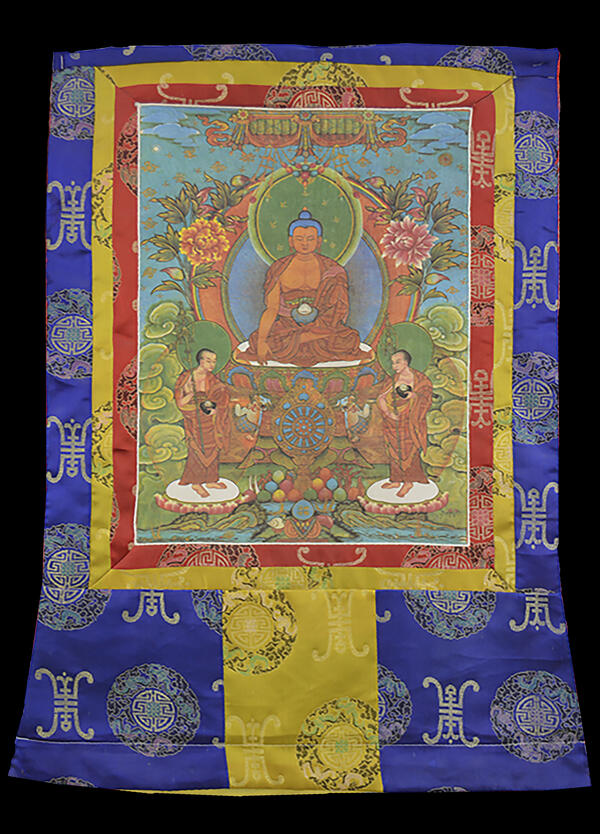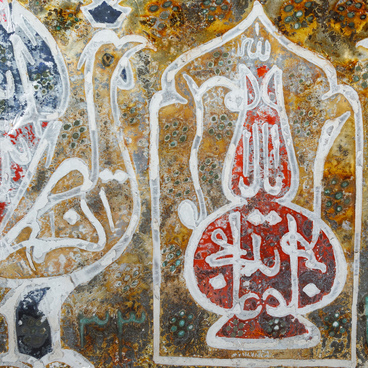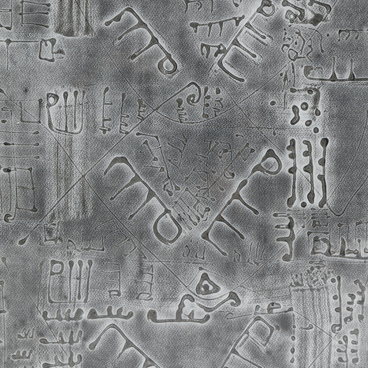A tanka is a Tibetan Buddhist painting on silk. The size of a tanka can range from a few square centimeters to several square meters. The tanka was created according to the strict canons of iconography and was used for home meditations, temple services and religious processions. The tanka from the collection of the Museum of the History of World Cultures and Religions belongs to the Tibetan school in India.
In the center is Buddha Shakyamuni, the founder of Buddhism. Traditionally he sits on a lotus throne, which has seven levels. The painting is composed according to certain proportions. The lower base rises up to the upper hexagonal one, decorated with patterns, where it is supported by two snow leopards, symbols of fearlessness on the path of enlightenment. Above is a lotus with solar and lunar disks. This throne has a back decorated with two lotuses on either side, which symbolize purity and divine birth.
The Buddha is painted according to the strict iconographic guidelines. He sits in a full lotus pose with a halo over his head, like Christian saints, yet his halo does not signify holiness, but the enlightened nature of human consciousness. Shakyamuni’s hair is blue, and on his head is an ushnisha, which allows him to communicate with the world on a subtle level. In his left hand, Shakyamuni Buddha holds a patra, a monk’s alms bowl, which symbolizes renunciation from worldly life.
Traditionally the bowl is made of metal to last longer and to be suitable for cooking on an open fire. The patra is depicted as deep blue in color, sometimes filled with water, rice, fruit, or a medicinal plant. According to another interpretation, the bowl is filled with three kinds of nectar: medicinal — to heal our body and mind; nectar of immortality — to give infinite life; and nectar of pure wisdom and unclouded consciousness — to overcome mental problems and obscurations.
The teacher’s right hand touches the ground, a gesture that distinguishes the historical Buddha and comes from the legend of how Shakyamuni, at the moment of his enlightenment, called upon the ground to bear witness. Above the Buddha’s head is an umbrella, a sign of glory and respect. This symbol of Buddhism is believed to protect against suffering, signifying good deeds done to protect all living things from disease and misfortune. The dome of the umbrella is a sign of wisdom, and the ruffles of silk hanging around the edges are various manifestations of compassion. To the right and left of Shakyamuni Buddha are the arhats, his first disciples. Sixteen of them are the most famous and were entrusted by the Buddha to preserve his teachings after his departure.
In the center is Buddha Shakyamuni, the founder of Buddhism. Traditionally he sits on a lotus throne, which has seven levels. The painting is composed according to certain proportions. The lower base rises up to the upper hexagonal one, decorated with patterns, where it is supported by two snow leopards, symbols of fearlessness on the path of enlightenment. Above is a lotus with solar and lunar disks. This throne has a back decorated with two lotuses on either side, which symbolize purity and divine birth.
The Buddha is painted according to the strict iconographic guidelines. He sits in a full lotus pose with a halo over his head, like Christian saints, yet his halo does not signify holiness, but the enlightened nature of human consciousness. Shakyamuni’s hair is blue, and on his head is an ushnisha, which allows him to communicate with the world on a subtle level. In his left hand, Shakyamuni Buddha holds a patra, a monk’s alms bowl, which symbolizes renunciation from worldly life.
Traditionally the bowl is made of metal to last longer and to be suitable for cooking on an open fire. The patra is depicted as deep blue in color, sometimes filled with water, rice, fruit, or a medicinal plant. According to another interpretation, the bowl is filled with three kinds of nectar: medicinal — to heal our body and mind; nectar of immortality — to give infinite life; and nectar of pure wisdom and unclouded consciousness — to overcome mental problems and obscurations.
The teacher’s right hand touches the ground, a gesture that distinguishes the historical Buddha and comes from the legend of how Shakyamuni, at the moment of his enlightenment, called upon the ground to bear witness. Above the Buddha’s head is an umbrella, a sign of glory and respect. This symbol of Buddhism is believed to protect against suffering, signifying good deeds done to protect all living things from disease and misfortune. The dome of the umbrella is a sign of wisdom, and the ruffles of silk hanging around the edges are various manifestations of compassion. To the right and left of Shakyamuni Buddha are the arhats, his first disciples. Sixteen of them are the most famous and were entrusted by the Buddha to preserve his teachings after his departure.



